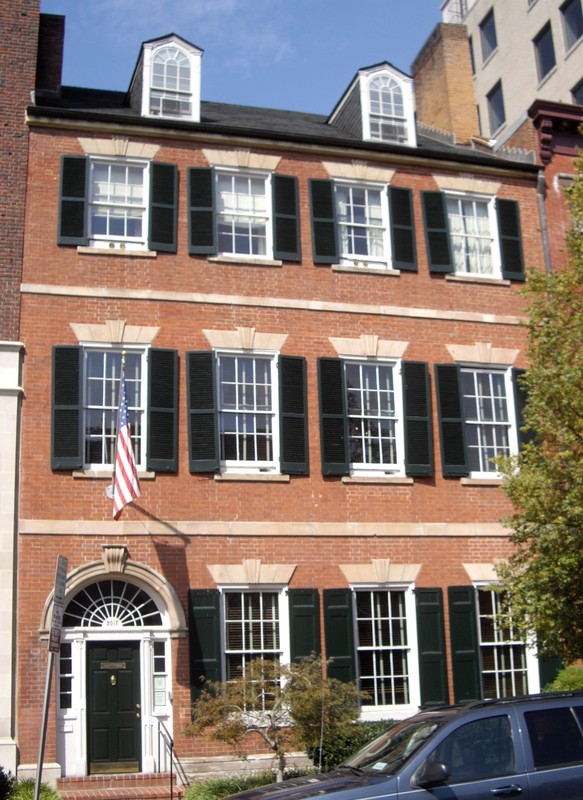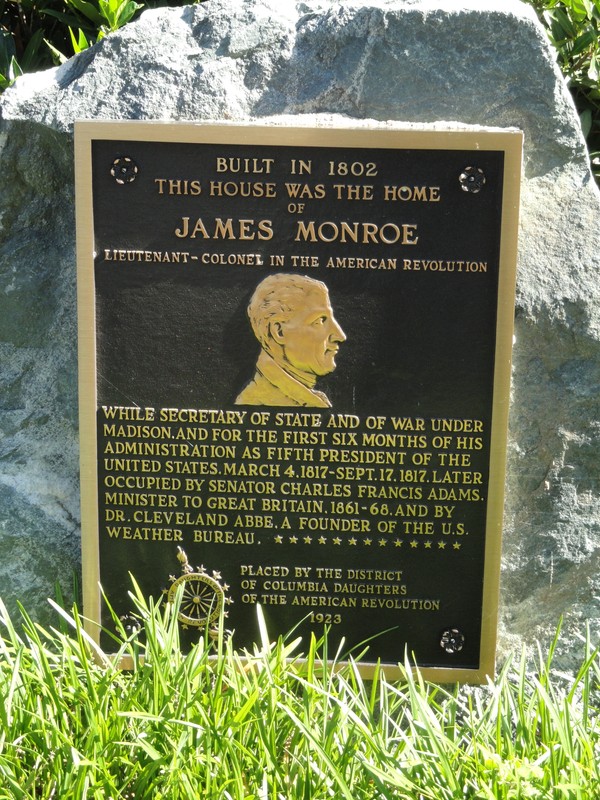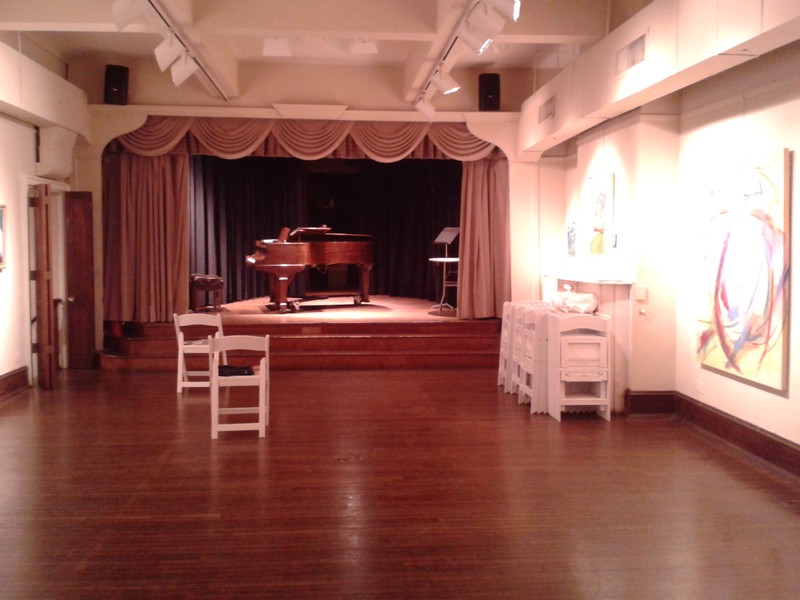The Cleveland Abbe House (Arts Club of Washington)
Introduction
Text-to-speech Audio
The Cleveland Abbe House (also known as The Monroe House, or the Caldwell-Monroe-Adams-Abbe House) is a red-brick row house in the Federal style, completed by businessman Timothy Caldwell in 1808. It first became historically significant as the house in which Secretary of State and War (and future President) James Monroe lived from 1811 to 1817. After Monroe was inaugurated as president, while the White House was still being restored, it became the presidential residence for several months.
Charles Francis Adams, Sr., the son and grandson of presidents, also lived in the house in the early 1860s. Its final private resident was the scientist Cleveland Abbe, who founded the U.S. Weather Bureau (now known as the National Weather Service), and who lived there from 1877 to 1909. After Abbe's death in 1916, the house was purchased by the newly-formed Arts Club of Washington.
The club still owns the house nearly a century later, and holds many arts-related events at the site. The house was entered into the National Register of Historic Places in 1969 and became a National Historic Landmark in 1975.
Images
Exterior of the Cleveland Abbe House

James Monroe plaque at the Cleveland Abbe House

Theatre at the Cleveland Abbe House (Interior)

Backstory and Context
Text-to-speech Audio
Timothy Caldwell, a wealthy Philadelphia businessman, began building a row house on I Street in Washington in 1806 and completed it two years later. He remained the owner of the property
until 1840. In 1811, James
Monroe, who served as both Secretary of State and Secretary of War under President James Madison, and his wife Elizabeth moved into the house, furnishing it with valued objects the couple had acquired
while he had served as America’s Minister to France in the 1790s. When the British invaded the capital during the
War of 1812, the original White House was burned down, and Monroe's house subsequently became the hub of social activity in the capital. When Monroe was inaugurated president in
March 1817, the White House was not yet fully restored, so Monroe used his own house as his official
residence until he moved into the renovated White House in September. His first inaugural ball was held in the
house's second floor parlor, which still exists.
Somewhat ironically, after the Monroes moved out, the house became the home of the British legation, where many diplomatic events were held. Charles Francis Adams, Sr. – the son of a president and the grandson (and biographer) of another – moved in and enjoyed a lively social life there in the early 1860s. His son, the future author Henry Adams, also lived there as a young man.
In 1840, Caldwell sold the property to Francis Markow, who in turn sold it to meteorologist Cleveland Abbe in 1877. Born in 1838, Abbe in his youth had dedicated his career to science. In 1868, he became director of the Cleveland Observatory and began his life’s work in meteorology there. Using the then-recent invention of the telegraph, he established in 1871 America’s first nationwide weather service, the United States Weather Bureau (later the National Weather Service).
Abbe moved to Washington that same year, intending to stay in the city only a short time, but remained for the rest of his life. He lived in the house that bears his name for over thirty years, from 1877 to 1909. He retired in 1916 at the age of 78, and died a few months later. More than a scientist and administrator, Abbe was a teacher and propagandist on behalf of the benefits of science. Curiously, the house was deemed a landmark because of its association with Abbe, not because President James Monroe, Charles Francis Adams and Henry Adams had all lived there, nor because it had served as the unofficial White House for about six months in 1817!
The structure is a red-brick row house, 32 feet wide, with three stories plus a dormered attic with a grey slate gable roof. The solid-wood entrance door, which is to the left of the first-floor windows viewed from the street, is a 20th century reproduction of the original. In 1881, Abbe built additional rooms in the rear on the upper floors and removed a stable and other outbuildings in the backyard. Non-original elements include a modern second floor concrete deck, fire escapes and a large fourth floor studio dormer.
The Arts Club of Washington was created in 1916, its founders inspired by similar clubs in London and New York. It was the first club in the nation's capital to admit women as charter members. Its first president was sculptor Henry K. Bush-Brown. In addition to a clubhouse, the Abbe House serves the Arts Club of Washington as an art gallery, performance space and symbol of preservation. The club gives an annual award, the National Award for Arts Writing, “in recognition of excellence in writing about the arts,” which is presented at a formal dinner at the Cleveland Abbe House. The club also provides scholarship awards to young artists.
Somewhat ironically, after the Monroes moved out, the house became the home of the British legation, where many diplomatic events were held. Charles Francis Adams, Sr. – the son of a president and the grandson (and biographer) of another – moved in and enjoyed a lively social life there in the early 1860s. His son, the future author Henry Adams, also lived there as a young man.
In 1840, Caldwell sold the property to Francis Markow, who in turn sold it to meteorologist Cleveland Abbe in 1877. Born in 1838, Abbe in his youth had dedicated his career to science. In 1868, he became director of the Cleveland Observatory and began his life’s work in meteorology there. Using the then-recent invention of the telegraph, he established in 1871 America’s first nationwide weather service, the United States Weather Bureau (later the National Weather Service).
Abbe moved to Washington that same year, intending to stay in the city only a short time, but remained for the rest of his life. He lived in the house that bears his name for over thirty years, from 1877 to 1909. He retired in 1916 at the age of 78, and died a few months later. More than a scientist and administrator, Abbe was a teacher and propagandist on behalf of the benefits of science. Curiously, the house was deemed a landmark because of its association with Abbe, not because President James Monroe, Charles Francis Adams and Henry Adams had all lived there, nor because it had served as the unofficial White House for about six months in 1817!
The structure is a red-brick row house, 32 feet wide, with three stories plus a dormered attic with a grey slate gable roof. The solid-wood entrance door, which is to the left of the first-floor windows viewed from the street, is a 20th century reproduction of the original. In 1881, Abbe built additional rooms in the rear on the upper floors and removed a stable and other outbuildings in the backyard. Non-original elements include a modern second floor concrete deck, fire escapes and a large fourth floor studio dormer.
The Arts Club of Washington was created in 1916, its founders inspired by similar clubs in London and New York. It was the first club in the nation's capital to admit women as charter members. Its first president was sculptor Henry K. Bush-Brown. In addition to a clubhouse, the Abbe House serves the Arts Club of Washington as an art gallery, performance space and symbol of preservation. The club gives an annual award, the National Award for Arts Writing, “in recognition of excellence in writing about the arts,” which is presented at a formal dinner at the Cleveland Abbe House. The club also provides scholarship awards to young artists.
Sources
http://artsclubofwashington.org/about/history-2
http://www.nps.gov/nr//travel/wash/dc43.htm
http://focus.nps.gov/pdfhost/docs/NHLS/Text/69000289.pdf
http://bit.ly/1UlwyPM
http://wheatoncollege.edu/news/2011/04/21/art-history-professor-honored
http://publicaffairs.cua.edu/success-stories/mark-thomas.cfm
http://wapo.st/1Mbtbo7
